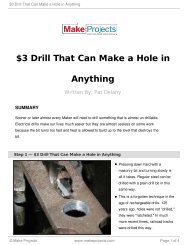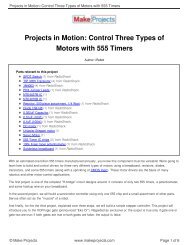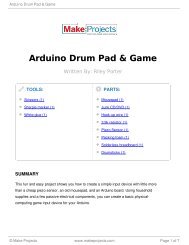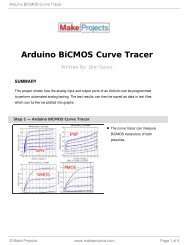You also want an ePaper? Increase the reach of your titles
YUMPU automatically turns print PDFs into web optimized ePapers that Google loves.
<strong>Marble</strong> <strong>Adding</strong> <strong>Machine</strong><br />
TOOLS:<br />
Band saw (1)<br />
Clamps (1)<br />
Computer (1)<br />
<strong>Marble</strong> <strong>Adding</strong> <strong>Machine</strong><br />
to print out plans from<br />
http://makezine.com/20/marble_adder<br />
Drill (1)<br />
Drill bits (1)<br />
The 11/16" bit, for the marble holes, is<br />
an unusual size; try a specialty<br />
woodworking supplier like Lee Valley<br />
Tools (leevalley.com), Woodcraft<br />
(woodcraft.com), or Rockler<br />
(rockler.com). Substituting ¾" holes<br />
won't align the marbles as well; 5/8"<br />
holes can work if you carefully select<br />
smaller marbles.<br />
Forstner bit (1)<br />
or fine band saw blade or scroll saw<br />
Keyhole saw (1)<br />
Table saw (1)<br />
Written By: Matthias Wandel<br />
PARTS:<br />
Plywood (1)<br />
for the backboard. I used birch.<br />
Hardwood (1)<br />
for the toggles and horizontal pieces. I<br />
used birch because I like its light color,<br />
but maple would also work.<br />
Wood (1)<br />
for the vertical pieces and base. I used<br />
spruce.<br />
Glue (1)<br />
Sandpaper (1)<br />
Nails (13)<br />
Washers (6)<br />
Screws (4)<br />
Spring (1)<br />
<strong>Marble</strong>s (12)<br />
© Make Projects www.makeprojects.com Page 1 of 12
<strong>Marble</strong> <strong>Adding</strong> <strong>Machine</strong><br />
SUMMARY<br />
Computers add binary numbers constantly, but we never see how. This elegant machine<br />
does the math using glass marbles.<br />
I started building marble track machines years ago using Lego. I experimented with all sorts<br />
of crazy ways for the marbles to descend. One was a rocker that shunted a stream of<br />
dropping marbles one-by-one to alternating sides. If you cascade three of these toggles<br />
down to the left, every marble flips the rightmost toggle, every second marble flips the<br />
middle toggle, and every fourth flips the leftmost. Interpret each toggle’s state as left = 0 and<br />
right = 1, and you have a binary counter. Add more toggles, and it can count more.<br />
I realized I could turn the counter into an adder by dropping marbles onto toggles other than<br />
the rightmost. I added a marble hold-and-release shelf up top to act as an input buffer,<br />
another underneath as an output buffer, and a clear-register mechanism to reset all toggles.<br />
I moved from Lego to wood, and refined the design a few times. Here’s the latest edition.<br />
© Make Projects www.makeprojects.com Page 2 of 12
<strong>Marble</strong> <strong>Adding</strong> <strong>Machine</strong><br />
Step 1 — Mark the layout on the blackboard.<br />
© Make Projects www.makeprojects.com Page 3 of 12
<strong>Marble</strong> <strong>Adding</strong> <strong>Machine</strong><br />
You can use my project plans, or<br />
you can design your own. Note that<br />
I use metric measurements in<br />
general, but standard sizes for the<br />
drill bits and some materials.<br />
Download the project plans from<br />
http://makezine.com/20/marble_adder<br />
and print them at full size, not<br />
scaled. If you can print oversize,<br />
use the full template plan.png.<br />
Otherwise, print out the tiled<br />
version, plan_p1 through plan_p4,<br />
and align and glue the 4 pieces<br />
together. Also print at full size the<br />
templates toggles_template.png,<br />
for Step 2, and sliders.png, for Step<br />
3.<br />
Cut the plywood to 400mm×280mm<br />
and clamp the template centered<br />
on top.<br />
Transfer the key locations from the<br />
template onto the plywood. For the<br />
positions of the holes, I used an<br />
awl to punch through the template<br />
and into the wood. For the<br />
horizontal and vertical pieces, I<br />
transferred the positions of key<br />
corners by punching lightly through<br />
the paper with a chisel. Be sparing<br />
in how many places you mark, and<br />
circle the points on the template<br />
where you marked the wood, so<br />
that after you remove it, you can<br />
still figure out what corresponds to<br />
© Make Projects www.makeprojects.com Page 4 of 12<br />
what.
<strong>Marble</strong> <strong>Adding</strong> <strong>Machine</strong><br />
Step 2 — Cut the toggles.<br />
Each toggle uses two 1¼" finishing<br />
nails: one provides the pivot that it<br />
spins around and the other sticks<br />
out the back for the reset<br />
mechanism. Use a closed-grain<br />
hardwood for the toggles and<br />
horizontal pieces, so they can<br />
withstand all the marble impacts.<br />
Cut out the 6 paper templates from<br />
the toggle template you printed in<br />
Step 1, and glue them onto 1×4<br />
hardwood. Use a band saw or<br />
jigsaw to cut the shapes out.<br />
For the pivot nail holes at the<br />
bottom, drill a centered 3/64" hole<br />
all the way through and countersink<br />
it with a 3/32" hole 2mm deep for<br />
the nail head to sit flush. For the<br />
reset nails, drill a 1/32" pilot hole<br />
from the back, going only 12mm<br />
deep.<br />
Sand the template paper off the<br />
toggles.<br />
© Make Projects www.makeprojects.com Page 5 of 12
<strong>Marble</strong> <strong>Adding</strong> <strong>Machine</strong><br />
Step 3 — Cut the verticals and horizontals.<br />
Cut the 11 vertical pieces, following the plan. I used spruce 2×6s. All are 19mm thick, front<br />
to back, and 18mm wide. Start with the 5 top pieces, which are just simple rails.<br />
For the 6 bottom vertical pieces, which have a cutout next to the toggle, cut 3 pieces just<br />
over 36mm wide. Using a 1 1/8" Forstner bit, drill holes centered 24mm down from the top,<br />
then cut the rails down the middle and trim to length. Don’t cut the holes with a spade bit,<br />
since that probably won’t cut cleanly. If you don’t have a 1 1/8" Forstner bit, you can cut<br />
the rounds out with a fine band saw blade or a scroll saw.<br />
Follow the template sliders.png that you printed in Step 1 to cut and drill the horizontal<br />
pieces: a feeder above each toggle, the input holder, input slider, input slider holder,<br />
bottom rail, result holder, result slider, result slider support blocks, and clear ramp. All<br />
holes are 11/16". I added some extra length to the clear ramp, not on the template, so the<br />
marbles could dump into a bowl more easily.<br />
As you cut the pieces, check them by laying them down in place on the paper<br />
template<br />
Deburr all the marble holes and use a knife or file to make a chamfer on the topside of<br />
each. Cutting against the grain will splinter the wood, so each hole requires a separate cut<br />
for each quadrant.<br />
© Make Projects www.makeprojects.com Page 6 of 12
<strong>Marble</strong> <strong>Adding</strong> <strong>Machine</strong><br />
Step 4 — Assemble the front.<br />
In the backboard, drill the 1/32" pilot holes for the toggle pivot nails. Above them, drill the<br />
holes for the toggle reset nails — two ¼" holes next to each other — then use a small saw<br />
or file to join the 2 holes, making an oblong shape. Drill and cut another oblong aperture for<br />
the stop screw at the left end of the result slider.<br />
It’s time to start gluing pieces to the backboard. First, glue down the input slider holder and<br />
bottom rail. Let the glue dry.<br />
Working from one side, glue down sets of 2 uprights and 1 horizontal for each bit position.<br />
Glue down the input holder and result slider support blocks (2nd photo). To make sure the<br />
sliders have enough room to slide comfortably, cut slider-sized spacers out of thin<br />
cardboard and sandwich them in with the sliders as you position the new pieces for gluing.<br />
Make sure the sliders remain unglued.<br />
Glue down the clear ramp. (So marbles wouldn’t fall off my extension to the clear ramp, I<br />
added a back piece there, which isn’t in the template.)<br />
(Optional) For aesthetics as much as anything, I glued beveled blocks at either end of the<br />
input holder and between the bottom rail and result holder. I also added small blocks<br />
between each result holder hole. These are not in the template.<br />
Attach the toggles. Nail the pivot nails into the back panels, threaded through the toggles<br />
with a small washer underneath. Turn the assembly over and nail the reset nails through<br />
the elongated holes into the other side of each toggle so that they protrude about 6mm.<br />
© Make Projects www.makeprojects.com Page 7 of 12
<strong>Marble</strong> <strong>Adding</strong> <strong>Machine</strong><br />
Step 5 — Add the release mechanism and base.<br />
© Make Projects www.makeprojects.com Page 8 of 12
<strong>Marble</strong> <strong>Adding</strong> <strong>Machine</strong><br />
Screw a 1½" #6 wood screw into<br />
the bottom slider, through its<br />
oblong hole in the backboard of the<br />
machine.<br />
Make the diagonal slider. It’s best<br />
to size this to your machine’s<br />
actual dimensions, rather than from<br />
plans. Tilt all the toggles to the 1<br />
position (right in front, left in back).<br />
Cut a slat of birch 5mm thick and<br />
23mm wide, and push it up against<br />
the nails in back. Use a pencil to<br />
mark where the nails touch the<br />
slat, then cut vertical notches down<br />
and to the right from each, so that<br />
they run under the oblong holes.<br />
For the next three bullets,<br />
the reference position for<br />
the diagonal slider is to the left<br />
(facing the back), with all toggles in<br />
the 1 position (see photo).<br />
Slide the bottom slider screw to<br />
the left in its hole. Referring to<br />
the photo, cut and glue block B<br />
to the bottom end of the diagonal<br />
slider (C), so that it hooks under<br />
the screw.<br />
Mark the left edge positions of<br />
the diagonal slider and block B.<br />
Cut and glue block A so that it<br />
rests against block B as a stop.<br />
Hammer a nail (H) into the<br />
bottom edge of the diagonal<br />
slider, hook it with a small spring<br />
or rubber band (G), and anchor<br />
© Make Projects www.makeprojects.com Page 9 of 12
<strong>Marble</strong> <strong>Adding</strong> <strong>Machine</strong><br />
Step 6 — Cont'd.<br />
the other end of G to the<br />
backboard with a ¾" #4 wood<br />
screw, so that it pulls the slider<br />
up and left, into the 1 position.<br />
Slide the diagonal slider up and to<br />
the right, perpendicular to its<br />
length. It should engage the slider<br />
screw and toggles so that they all<br />
flip to the 0 position. Mark its right<br />
edge.<br />
Cut L-shaped blocks D and E to<br />
stay the diagonal slider on each<br />
side, making sure it will still slide<br />
between 0 and 1. Glue D to the<br />
backboard and attach E with a ¾"<br />
screw, to make the slider<br />
removable.<br />
For the base, bevel a piece of 2×6<br />
wood with a 20° angle, then drill<br />
and screw the bottom of the<br />
backboard to it. I used three 1½"<br />
#6 wood screws, spaced out.<br />
That’s it; you’ve made it!<br />
For reinforcement (optional)<br />
you can run a vertical strut<br />
from the base to the top of the<br />
backboard, as I did with my<br />
prototype (as in the photo).<br />
© Make Projects www.makeprojects.com Page 10 of 12
<strong>Marble</strong> <strong>Adding</strong> <strong>Machine</strong><br />
Step 7 — Design your own.<br />
Debugging<br />
Chances are, your machine will need a bit of debugging to get it working perfectly. Filing here<br />
and there will smooth the marbles’ journey.<br />
Hopefully, the 20° angle will keep marbles from getting ejected out the front of the machine, but<br />
if they do fall out, it may help to carve out the back edges of the holes that the marbles pass<br />
through. You can also just re-bevel the base to mount the machine at a 30° angle instead of 20°.<br />
<strong>Adding</strong> Value<br />
For maximum marble action, add 63 (111111 in binary) to 63.<br />
If you want to use your own<br />
template, try prototyping a 1-bit<br />
It’s also fun to use the adder for subtraction and negative numbers by using the two’s<br />
adder first, since it’s tricky getting<br />
a toggle shape and configuration<br />
that work reliably.<br />
To test the whole machine later,<br />
put it together using just hot glue<br />
for the non-moving pieces so you<br />
can pry them off to reshape or<br />
reposition them.<br />
The MSB (most significant bit)<br />
marbles on the left have a long<br />
drop, so you should confirm that<br />
they stay on track and don’t<br />
bounce out.<br />
complements of numbers. This means interpreting the leftmost bit as the positive or negative<br />
sign, and flipping all the other bits to convert from positive to negative. For our 6-bit adder, this<br />
gives a number range from –31 (100000) to 31 (011111). <strong>Adding</strong> –1 to –1 is the same operation<br />
as adding 63 to 63 above, and it results in 111110, the 6-bit two’s-complement representation for<br />
© Make Projects www.makeprojects.com Page 11 of 12
<strong>Marble</strong> <strong>Adding</strong> <strong>Machine</strong><br />
–2.<br />
In general, it’s fun to subtract 1 from numbers, because nearly the same number results, but<br />
with all the original marbles dumped and replaced by new marbles.<br />
I invented my marble adder independently, but people have since emailed me about 2<br />
educational games from the 1960s with which it shares some similarities, named Dr. Nim and<br />
Digi-Comp II.<br />
Multiplying Possibilities<br />
I have spent time trying to come up with multiplier designs, but everything I’ve thought of lacks<br />
the gee-whiz simplicity of the adder. I’d want to multiply not by adding the number to itself N<br />
times, but by shifting the number to be added, and adding it to the other argument in each shifted<br />
position. Such a machine would no doubt involve a lot of sequencing and require gears and such,<br />
but I haven’t come up with a specific design that has simple appeal.<br />
Suggestions are welcome!<br />
This project first appeared in MAKE Volume 20.<br />
This document was last generated on 2012-11-03 02:57:51 AM.<br />
© Make Projects www.makeprojects.com Page 12 of 12

















